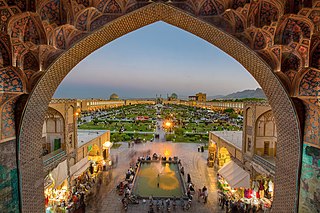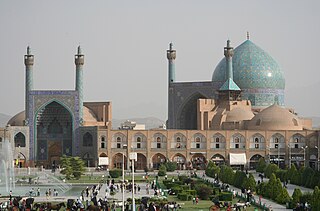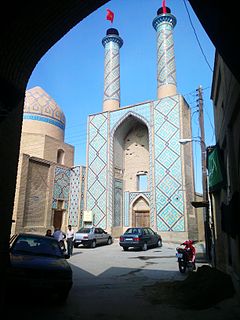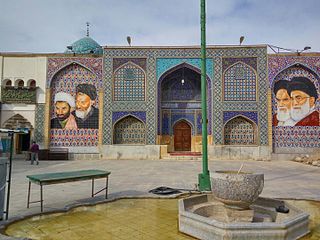
Isfahan, historically also rendered in English as Ispahan, Spahan, Sepahan, Esfahan or Hispahan, is a major city in Iran, Greater Isfahan Region. It is located 406 kilometres south of Tehran and is the capital of Isfahan Province.

Khorramabadpronunciation (help·info) is a city and the capital of Lorestan Province, Iran. At the time of the 2006 census, its population was 328,544, in 75,945 families. Khorramabad is situated on the Zagros Mountains. Khorramabad Airport is 3 km south of the city proper.

The Shah Mosque is a mosque located in Isfahan, Iran. It is located on the south side of Naghsh-e Jahan Square. It was built during the Safavid dynasty under the order of Shah Abbas I of Persia.

Damghan is the capital of Damghan County, Semnan Province, Iran. At the 2006 census, its population was 57,331, in 15,849 families. It is situated 342 km (213 mi) east of Tehran on the high-road to Mashad, at an elevation of 1,250 m (4,101 ft). It is one of the oldest cities on the Iranian plateau, stretching back 7,000 years, and boasts many sites of historic interest. The oldest of these is Tappeh Hessar, lying to the southeast of the city, which holds the ruins of a castle dating from the Sasanian Empire.

Zavareh is a city and capital of Zavareh District, in Ardestan County, Isfahan Province, Iran. At the 2006 census, its population was 7,806, in 2,197 families.

The Jāmeh Mosque of Nā'īn is the grand, congregational mosque (Jāmeh) of Nā'īn city, within Isfahān Province of Iran. Although the mosque is one of the oldest in Iran, it is still in use and is protected by Iran's Cultural Heritage Organization.

The Monar Jonban, is a monument located in Esfahan, in central Iran. Construction began in the 14th century Safavid or Ilkhanate dynasties of Iran to cover the grave of Sufi Amu Abdollah Soqla. Its notable feature is that if one of the minarets is shaken, the other minaret will shake as well.

Ali minaret is a historical minaret in Isfahan, Iran. It is close to the Ali mosque. This minaret is the oldest minaret in Isfahan, which dates back to the 11th century. This minaret is 52 metres (171 ft) in height and is the second highest historical minaret in Isfahan after the Sarban minaret. It is said that this minaret was originally 54 metres (177 ft), but its height has been decreased 2 metres in the course of time. There are four inscriptions on the Ali minaret. One of the inscriptions is made of brick and the others are made of ceramic.

Chehel Dokhtaran minaret is a historical minaret in Isfahan, Iran. It is located in the Jouybareh district of Isfahan. According to the kufic inscription on the minaret, it is built in 1112. It is the fifth oldest minaret in Iran, which has an inscription. There's a big window on the minaret, which faces the qibla. This feature does not exist in other minarets of Isfahan. There is a spiral staircase in the minaret, which leads to the top of it. This minaret is 40 meters high. Originally, the minaret was higher, but in the course of time its height has been decreased. The minaret towers over the city quarter and can be seen from the far distance, but it is difficult to reach it through the mazes of winding alleys and narrow streets.

Sarban minaret is a historical minaret in Isfahan, Iran. It dates back to the Seljuq era. The Sarban minaret is located in the north of Jouybareh district, not far from Chehel Dokhtaran minaret. It seems that there was a mosque beside this minaret in the past, but it does not exist any more. The minaret consists of seven different parts. The first part has brick bolster work. The second and third parts have masterly decorative brickwork. The fourth part is its first crown, which has brick muqarnas with turquoise tiles. The fifth part has decorative bricks. the sixth part is the second crown and the seventh part is the vertex of the minaret. The minaret is 54 m high and is the highest historical minaret in the Isfahan province.

Dardasht minarets are two historical minarets in Isfahan, Iran. These minarets are on a portal in the neighborhood of Soltan Bakht Agha Mausoleum. These minarets date back to the era of the Muzaffarids. The top part of the minaret has been destroyed.

Bagh-e-Ghoushkhane minaret(Persian: مناره باغ قوشخانه) is a historical minaret in Isfahan, Iran. This minaret dates back to the 14th century. In the olden days it was in the neighborhood of the old city gate. Because of its proximity to the Ali ebn-e Sahl mausoleum it is also known as Ali-ebn-e-Sahl minaret. Its newest famous name is Bagh-e-Ghoushkhane minaret, because of its proximity to the Ghushkhaneh garden. A part of its vertex and tiles have collapsed.

The Emamzadeh Haroun-e-Velayat, or the Harun-i Vilayat Mausoleum, is an imamzadeh in Isfahan, Iran. It is located opposite the Ali minaret in Dardasht and belongs to the Ismail I era. There are many accounts of Harun Vilayat, the person who is buried in it. Some say that he is the sixth Imam's son and others, that he is the tenth Imam's son, but aside from the matter of who is buried in it, it is the most important historical structure related to the early Safavid era. Beyond the tomb it has also a portico, a tiled dome and a large yard.

Emamzadeh Esmaeil and Isaiah mausoleum is a historical complex in Isfahan, Iran, which dates back to the Seljuk and Safavid era. This complex is located near the Jameh Mosque of Isfahan, in the Hatef street and contains two mausoleums, one believed to be for Esmaeil, one of grandsons of Hasan ibn Ali, and another which is believed to be Isaiah's.

The Gar mosque and minaret are historical structures located in Gar village in the Isfahan province. The minaret dates back to Seljuq era, but the mosque belongs to the Ilkhanid age. The only remained part of the mosque is its mihrab, which has been decorated with stuccoes, but the minaret is relatively in a good condition and according to its inscription, it was built in 1121 by Abolghassem ebn-e Ahmad.

The Barsian mosque and minaret are historical structures in the Isfahan province. Barsian, which was originally Parsian in the past, is a village located 42 km east of Isfahan. According to the inscriptions the mosque was built in 1105 and the minaret was built in 1098 in the era of Barkiyaruq, the Seljuq king. The minaret is the fourth old minaret in Iran, which has an inscription. It is 34 m high. Its bottom part has simple bricks, but the upper parts have been decorated by decorative bricks.

The Chehel Dokhtaran mausoleum is a historical structure in Kashan, Iran. It is located to the west of Emamzadeh Soltan Mir Ahmad. The mausoleum was built in the Ilkhanid era. Its high simple unadorned dome is the hallmark of the architecture in the Ilkhanid era.

The Khaje Taj od-Din mausoleum is a historical structure in Kashan, Iran. In the 15th century, Khaje Taj od-Din, the brother of founder of Zeyn od-Din minaret, Khaje Zeyn od-Din, built a mosque with minarets and a school on the tombs of two Imamzadehs and some of his contemporary scientists and judges. In the course of time the mosque and minarets and school were destroyed and only two domes remained, which is named Khaje Taj od-Din mausoleum. The outer surface of its eastern dome has tile mosaic. Around the dome, it has been decorated with three rows of raised stucco inscriptions. The inscriptions are some poems in the Naskh and Thuluth scripts.

The Ziyar minaret is a historical minaret in the Isfahan province in Iran. The minaret is located 33 km to the east of Isfahan city near the village Ziyar on the southern side of Zayanderud. It is 51 m high and is the second highest historical minaret in the province Isfahan after the Sarban minaret and the only three-storey minaret in the province, the height of which has not decreased in the course of time. No construction dates have been mentioned in its kufic inscriptions, but because of its similarity to the minarets of Seljukid era, it is estimated that it was built in the 12th century. The crown of the minaret has turquoise tiles.

The Sepahsālār Mosque is a famous historic mosque in Tehran, Iran. The construction project of the mosque was started in 1879 upon the order of Mirza Hosein Sepahsalar, the Premiers of Iran during Naser al-Din Shah Qajar, and the first phase of construction was finished after five years since it was started. The mosque was renamed the Shahid Motahhari, after the 1979 Iranian Revolution, but it is commonly known as its initial name of Sepahsalar Mosque.


















